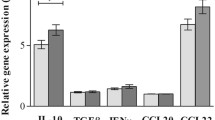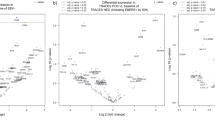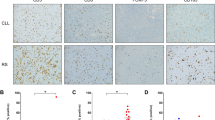Abstract
The tumor microenvironment of classical Hodgkin lymphoma (cHL) is clearly responsible for the maintenance of the malignant Hodgkin-Reed–Sternberg (HRS) cells, and Epstein–Barr virus (EBV) has been shown to play a role in this immune evasion. EBV can increase the migration of CD4+CD25+FOXP3+ lymphocytes, named regulatory T cells (Tregs). In this study, we assessed the distribution and biological significance of Tregs in patients with cHL. Tissue microarrays were constructed using diagnostic biopsies available in 130 cHL patients and stained with CD4, CD8, CD25, and FOXP3 antibodies. For the present study, only cHL patients whose histology could be confirmed and EBV association established were studied. From the 130 cHL patients selected for this study, 56 were classified as EBV-related and 74 EBV non-related cHL. There were no association between clinical characteristics and the expression of Tregs. However, higher levels of Tregs correlated with EBV presence on HRS cells (p = 0.02), although it did not influence event-free survival (EFS) and overall survival (p = 0.98 and p = 0.59, respectively). This study demonstrates that Tregs expression correlates with EBV presence in HRS cells and has no impact on survival of patients with cHL. Further studies investigating the mechanisms in which EBV recruits Tregs to the tumor microenvironment will contribute not only to our understanding on the pathogenesis of cHL but also to the development of new therapeutic strategies.
Similar content being viewed by others
Avoid common mistakes on your manuscript.
Introduction
Classical Hodgkin lymphoma (cHL) is characterized by the presence of rare neoplastic Hodgkin-Reed–Sternberg (HRS) cells embedded in an inflammatory background of nonmalignant cells [1, 2]. The majority of these cells are usually T lymphocytes with variable numbers of other cells, such as macrophages, neutrophils, eosinophils, and plasma cells [1]. The mechanisms of how HRS cells perpetuate in this inflammatory milieu remain controversial, and Epstein–Barr virus (EBV) has been shown to play a role in this immune evasion [3]. EBV can be found latently infecting HRS cells in approximately 50 % of all cases and can increase the migration of a subset of regulatory CD4+ T cells (Tregs) to the tumor microenvironment, characterized by a CD4+CD25+FOXP3+ phenotype [3, 4]. Tregs have become the focus of interest, given the critical role of these cells in the modification of immune responses, particularly suppression of tumor-associated antigen-reactive lymphocytes [5]. Increased Tregs in the tumor microenvironment were found to correlate with an unfavorable prognosis in ovarian carcinoma [6] and non-small cell lung cancer [7], whereas data regarding the importance of Tregs on the prognosis of cHL remain controversial. Some studies have shown that Tregs are a positive prognostic marker in cHL [8, 9], although Schreck et al. [10] showed that Tregs negatively influenced the prognosis with a high risk of relapse.
Understanding the mechanisms in which the tumor microenvironment fosters immune privilege enabling HRS cells to escape host anticancer immune response is crucial for the development of new therapy strategies. We, therefore, decided to quantify CD4+CD25+FOXP3+ regulatory T cells in the tumor microenvironment, correlate with the presence of EBV in HRS cells and further analyze the possible influence of these cells on the outcome of cHL patients.
Materials and methods
A total 130 cases of cHL diagnosed between 1980 and 2008 were selected for this study. All cases were treated at the University Hospital São Paulo and the Hospital A.C. Camargo, both of which are located in the city of São Paulo, Brazil. The two selected hospitals are public hospitals and responsible for the assistance of nearly 4 million people. Patients were only included in this study if they had: (1) negative HIV serology, (2) paraffin blocks available with enough material for tissue microarray (TMA) construction, histological reclassification, and for EBV detection, and (3) clinical, epidemiological, and laboratorial parameters available after a thorough chart review. All patients were initially treated with curative intent according to the standard of care at the time of diagnosis. However, owing to the long study period, standards of care changed, and, consequently, the study patients did not receive uniform treatment. All patients received either MOPP (mechlorethamine, vincristine, procarbazine, and prednisone), MOPPABV (mechlorethamine, vincristine, procarbazine, prednisone, doxorubicin, bleomycin, and vinblastine), or ABVD (doxorubicin, bleomycin, vinblastine, and dacarbazine) chemotherapy protocols and had locally extensive or advanced-stage disease at diagnosis. Locally, extensive disease was defined by clinical stages I–II–A/B (Ann Arbor Staging System) with massive mediastinal adenopathy (mass ≥ 1/3 maximum intrathoracic diameter on standing posteroanterior chest X-rays) and advanced disease defined as stages III–IV. Between 1980 and 1994, the standard protocol applied in both Institutions was MOPP; between 1994 and 1999, the treatment used was MOPPABV hybrid regimen, and after 1999, ABVD has been used. The response to primary treatment was classified according to the International Workshop criteria [11].
Tissue microarray (TMA) was constructed and validated as described elsewhere [12]. Each case was spotted in duplicate. Briefly, the richest areas of HRS cells were marked in the paraffin blocks. One-millimeter diameter cylinders from two different areas were included in each case, along with different controls, to ensure reproducibility and homogenous staining of the slides. Immunohistochemistry was performed manually, as previously described [13], with primary antibodies to CD4, CD8, CD25, FOXP3 (BD Biosciences, San Jose, CA, USA). After staining, images were obtained and analyzed using the Aperio ScanScope XT Slide Scanner (Aperio Technologies, Vista, CA, USA) and the Aperio ImageScope Software with the Aperio Positive Pixel Count Sample Macro algorithm (version 10.2.2.2317, Aperio Technologies, Vista, CA, USA). A previously known positive case of cHL was used as an external positive control. Unequivocal co-expression of FOXP3 and CD4 and CD25 was detectable on triple-stained slides, while expression of FOXP3 on CD4- or CD25-negative cells was not observed. Immunohistochemical scoring ranged from 1 to 4 for the antibodies tested, with higher scores indicating a greater proportion of positive cells. For CD4+CD25+FOXP3+ quantification, score 1 was considered negative (< 25 % of CD4+CD25+FOXP3+ cells) and scores 2, 3, and 4 (more than 25 % of positive cells) were considered positive. Determination of EBV association in tumor biopsies was done by in situ hybridization (ISH) for EBV-encoded RNA (EBER) and immunohistochemistry (IHC) for LMP1 following previously established procedures [14].
This research was submitted to the Brazilian Research Council and approved by the ethical review committee of both Institutions according to the Declaration of Helsinki.
Statistical analysis
Statistical analysis including data description was done using the Statistical Package of Social Sciences 16.0 software (Chicago, IL, USA). Clinical variables evaluated in the study were age, gender, presence of systemic symptoms (B symptoms), bulky disease, Eastern Cooperative Oncology Group performance status, clinical stage, International Prognostic Score (IPS), and treatment response. Differences in baseline patients and disease characteristics, including Tregs quantification, between EBV-positive and EBV-negative cHL cases were compared using either Chi-square test, Fisher exact test, or Mann–Whitney test. The association between EBV status and Tregs quantification was analyzed using logistic regression with results expressed as odds ratios (ORs) and 95 % confidence intervals (CIs). All Ps are based on two-tailed distributions. Results were considered significant for values of p < 0.05. Actuarial survival curves were compiled using the Kaplan–Meier method, and log-rank tests were used to compare curves. Overall survival (OS) was calculated from the date of diagnosis to the date of death or the last follow-up. Event-free survival (EFS) was calculated from the start of the treatment to the date of progression, death, or last follow-up.
Results
This study included 130 patients with cHL diagnosed between 1980 and 2006. The median age was 30 years (ranging from 07 to 92) and 67 patients were male (51.5 %). According to W.H.O. classification, nodular sclerosis (NS) histologic subtype was found in 86 patients (66.1 %). The majority of patients presented with advanced disease (stages III and IV) at diagnosis (n = 79; 60.8 %) and with systemic B symptoms (n = 76; 58.4 %). The median follow-up was 96 months (ranging from 02 to 300 months).
From the 130 cHL patients selected for this study, 56 (43 %) were classified as EBV-related and 74 (57 %) EBV non-related cHL. The patient’s clinical and epidemiological characteristics according to EBV status are summarized in Table 1. Mixed cellularity subtype was more common in the EBV-related group (p = 0.001). The expression of CD4+, CD25+, and FOXP3+ cells alone or together (CD4+CD25+FOXP3+) was more common in the EBV-related cHL group (p = 0.02). Response to treatment, either complete response (CR) or partial response (PR), and relapse rate were independent of Tregs quantification and EBV status. (p = 0.65, p = 0.12, respectively). When stratified according to the chemotherapy protocol used or disease stage (localized or advanced), we still did not find any difference.
Increased expression of CD4+CD25+FOXP3+ in the tumor microenvironment did not influence event-free survival (EFS) and overall survival (OS) (p = 0.98 and p = 0.59, respectively) in this group of patients (Fig. 1). For further analysis, we stratified our patients into two groups according to EBV status and CD4+CD25+FOXP3+ (Tregs) quantification: EBV(−)Tregs(−) and EBV(−)Tregs(+); EBV(+)Tregs(−) and EBV(+)Tregs(+) and we still did not find any difference on EFS and OS (p = 0.92 and p = 0.95, respectively) for the EBV-negative group and for the EBV-positive group (p = 0.11 and p = 0.08, respectively) (Fig. 2). Also, when we considered negative score 1 and 2 (< 50 % of CD4+CD25+FOXP3+ of positive cells) and positive score 3 and 4 (more than 50 % of positive cells), we still did not find any impact on EFS and OS (p = 0.09 and p = 0.12, respectively). Additionally, stratified survival analysis according to IPS-risk group and stage did not identify any impact of Tregs quantification on EFS and OS (data not shown).
a Event-free survival and b Overall survival curves according to CD4CD25Foxp3 positivity in 130 patients with classical Hodgkin lymphoma. CD4CD25Foxp3 (+) indicates more than 25 % CD4CD25Foxp3 + lymphocytes in the tumor microenvironment, and CD4CD25Foxp3 (−) indicates less that 25 % CD4CD25Foxp3 + lymphocytes
a Event-free survival and b Overall survival curves according to CD4CD25Foxp3 positivity in 74 patients with Epstein–Barr virus non-related classical Hodgkin lymphoma (cHL). c Event-free survival and d Overall survival curves according to CD4CD25Foxp3 positivity in 56 patients with Epstein–Barr virus-related classical Hodgkin lymphoma. EBV(−) indicates EBV non-related cHL; EBV(+) indicates EBV-related cHL; CD4CD25Foxp3 (+) indicates more than 25 % CD4CD25Foxp3 + lymphocytes in the tumor microenvironment, and CD4CD25Foxp3 (−) indicates less that 25 % CD4CD25Foxp3 + lymphocytes
Discussion
This study demonstrates that increased Tregs in the tumor microenvironment of cHL patients correlates with EBV presence in HRS cells and has no impact on survival of patients with cHL. The key features of the impaired immune response in cHL remain poorly understood, and recent studies suggest that the cellular composition of the tumor microenvironment, particularly the quantity of tumor-infiltrating Tregs, is crucial for the immune evasion of HRS cells [15, 16]. Understanding how Tregs are recruited to cHL tumor tissues is being addressed in recent studies, and EBV may play an important role in creating this anergic environment [3, 4]. Additionally, in cHL, an increased number of Tregs is associated with loss of EBV-specific immunity, whereas depletion of Tregs from peripheral blood mononuclear cells (PBMCs) enhances EBV-specific immunity [15]. In our study, the presence of EBV in HRS cells correlated with increased Tregs quantification in the tumor microenvironment. The recruitment of Tregs to tumors is poorly understood and might involve several chemokines. It has recently been shown that EBV up-regulates the expression of CCL20 in cHL cells leading to an increased chemotaxis of Tregs, enabling the escape of EBV-infected HRS cells from virus-specific cytotoxic response [3].
We also showed that an increased number of Tregs in the tumor microenvironment does not correlate with treatment response nor survival. Our results are different from those recently reported by Kelley et al. [17], Alvaro et al. [9] and Tzankov et al. [8] showing that Tregs are a positive prognostic marker in cHL. Probably, our results reflect the reality of the Brazilian population, highlighting the importance of studying different populations from different countries. Also, our study may differ from theirs regarding patient selection and treatment used. It is well known that the incidence of EBV-related cHL in developing countries is different from that in developed ones, as well as the severity of the disease at presentation. In our study, the majority of cases had advanced disease at diagnosis (60.8 %) and presented with B symptoms (58.4 %). Therefore, our results emphasize the importance of studying the Brazilian population and also bring to our attention the need for greater efforts regarding public health policies in our country, allowing earlier diagnosis in order to achieve better therapeutic results. We know that retrospective studies are prone to pitfalls, but we believe that our rigorous selection and review of cases make our data reliable and unique for the Brazilian population. This study covered a 28-year period in two public hospitals in São Paulo city, and we acknowledge the fact that this long period could have influenced our results. Noteworthy, clinical outcome of cHL has not changed much since early 70 s, as well as the prevalence of EBV-related cHL in our midst.
Further studies investigating the mechanisms in which EBV recruits Tregs to the tumor microenvironment and its impact on the clinical evolution of cHL will contribute not only to our understanding on the pathogenesis of cHL but also to the development of therapeutic strategies designed to manipulate Treg activity.
References
Skinnider BF, Mak TW. The role of cytokines in classical Hodgkin lymphoma. Blood. 2002;99:4283–97.
Poppema S. Immunobiology and pathophysiology of Hodgkin lymphomas. Hematol Am Soc Hematol Educ Progr. 2005;1:231–238.
Baumforth KR, Birgersdotter A, Reynolds GM, Wei W, Kapatai G, Flavell JR, Kalk E, Piper K, Lee S, Machado L, Hadley K, Sundblad A, Sjoberg J, Bjorkholm M, Porwit AA, Yap LF, Teo S, Grundy RG, Young LS, Ernberg I, Woodman CB, Murray PG. Expression of the Epstein-Barr virus-encoded Epstein-Barr virus nuclear antigen 1 in Hodgkin’s lymphoma cells mediates Up-regulation of CCL20 and the migration of regulatory T cells. Am J Pathol. 2008;173:195–204.
Ishida T, Ishii T, Inagaki A, Yano H, Komatsu H, Iida S, Inagaki H, Ueda R. Specific recruitment of CC chemokine receptor 4-positive regulatory T cells in Hodgkin lymphoma fosters immune privilege. Cancer Res. 2006;66:5716–22.
Levings MK, Roncarlo MG. T-regulatory 1 cells: a novel subset of CD4 T cells with immunoregulatory properties. J Allergy Clin Immunol. 2000;106:S109–12.
Curiel TJ, Coukos G, Zou L, Alvarez X, Cheng P, Mottram P, Evdemon-Hogan M, Conejo-Garcia JR, Zhang L, Burow M, Zhu Y, Wei S, Kryczek I, Daniel B, Gordon A, Myers L, Lackner A, Disis ML, Knutson KL, Chen L, Zou W. Specific recruitment of regulatory T cells in ovarian carcinoma fosters immune privilege and predicts reduced survival. Nat Med. 2004;10:942–9.
Shimizu K, Nakata M, Hirami Y, Yukawa T, Maeda A, Tanemoto K. Tumor-infiltrating Foxp3 + regulatory T cells are correlated with cyclooxygenase-2 expression and are associated with recurrence in resected non-small cell lung cancer. J Thorac Oncol. 2010;5:585–90.
Tzankov A, Meier C, Hirschmann P, Went P, Pileri SA, Dirnhofer S. Correlation of high numbers of intratumoral FOXP3 + regulatory T cells with improved survival in germinal center-like diffuse large B-cell lymphoma, follicular lymphoma and classical Hodgkin’s lymphoma. Haematologica. 2008;93:193–200.
Alvaro T, Lejeune M, Salvadó MT, Bosch R, García JF, Jaén J, Banham AH, Roncador G, Montalbán C, Piris MA. Outcome in Hodgkin’s lymphoma can be predicted from the presence of accompanying cytotoxic and regulatory T cells. Clin Cancer Res. 2005;11:1467–73.
Schreck S, Friebel D, Buettner M, Distel L, Grabenbauer G, Young LS, Niedobitek G. Prognostic impact of tumour-infiltrating Th2 and regulatory T cells in classical Hodgkin lymphoma. Hematol Oncol. 2009;27:31–9.
Brepoels L, Stroobants S, De Wever W, Spaepen K, Vandenberghe P, Thomas J, Uyttebroeck A, Mortelmans L, De Wolf-Peeters C, Verhoef G. Hodgkin lymphoma: response assessment by revised international workshop criteria. Leuk Lymphoma. 2007;48:1539–47.
Cunha IW, Lopes A, Falzoni R, Soares FA. Sarcomas often express constitutive nitric oxide synthases (NOS) but infrequently inducible NOS. Appl Immunohistochem Mol Morphol. 2006;14:404–10.
Campos AH, Aldred VL, Ribeiro KC, Vassallo J, Soares FA. Role of immunoexpression of nitric oxide synthases by Hodgkin and Reed-Sternberg cells on apoptosis deregulation and on clinical outcome of classical Hodgkin lymphoma. Mol Cell Biochem. 2009;321:95–102.
Murray PG, Young LS, Rowe M, Crocker J. Immunohistochemical demonstration of Epstein Barr virus encoded latent membrane protein in paraffin sections of Hodgkin’s disease. J Pathol. 1992;166:1–5.
Gandhi MK, Lambley E, Duraiswamy J, Dua U, Smith C, Elliott S, Gill D, Marlton P, Seymour J, Khanna R. Expression of LAG-3 by tumorinfiltrating lymphocytes is coincident with the suppression of latent membrane antigen-specific CD8 T-cell function in Hodgkin lymphoma patients. Blood. 2006;108:2280–9.
Marshall NA, Christie LE, Munro LR, Culligan DJ, Johnston PW, Barker RN, Vickers MA. Immunosuppressive regulatory T cells are abundant in the reactive lymphocytes of Hodgkin lymphoma. Blood. 2004;103:1755–62.
Kelley TW, Pohlman B, Elson P, Hsi ED. The ratio of FOXP3 + regulatory T cells to granzyme B + cytotoxic T/NK cells predicts prognosis in classical Hodgkin lymphoma and is independent of bcl-2 and MAL expression. Am J Clin Pathol. 2007;128:958–65.
Acknowledgments
This study was supported by the CNPq Research Council (563010/2008-8).
Conflict of interest
The authors reported no potential conflicts of interest.
Author information
Authors and Affiliations
Corresponding author
Rights and permissions
About this article
Cite this article
Assis, M.C.G., Campos, A.H.F.M., Oliveira, J.S.R. et al. Increased expression of CD4+CD25+FOXP3+ regulatory T cells correlates with Epstein–Barr virus and has no impact on survival in patients with classical Hodgkin lymphoma in Brazil. Med Oncol 29, 3614–3619 (2012). https://doi.org/10.1007/s12032-012-0299-4
Received:
Accepted:
Published:
Issue Date:
DOI: https://doi.org/10.1007/s12032-012-0299-4






